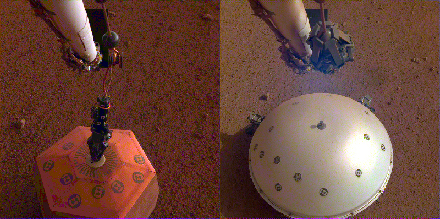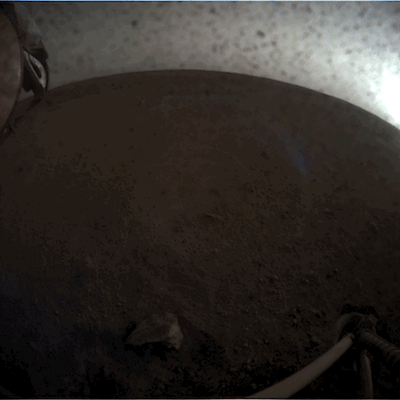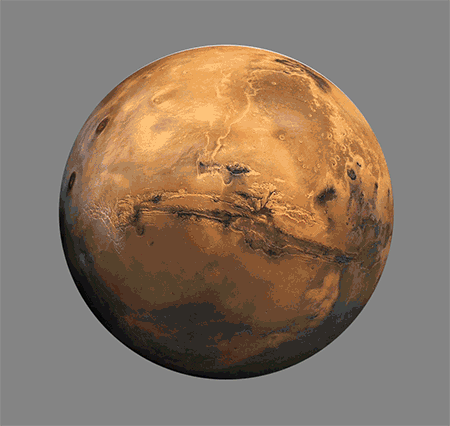At 5:54 p.m. Greenwich Mean Time in Potsdam, Germany, a horizontal pendulum suddenly started shaking. The pendulum scratched out spikes in ground movement for a few hours before settling down.
All of this sounds perfectly typical for a seismograph, but in fact, the event was quite extraordinary: The date was 17 April 1889, and this was the first recorded teleseismic event, a magnitude 5.8 earthquake that had shaken Tokyo, Japan, a little more than an hour prior.
Now, 130 years after that Tokyo quake kicked off the modern science of terrestrial seismology, a more sophisticated seismometer is retracing those first shaky steps 225 million kilometers and a planet away.
“We are at the birth of seismology on Mars,” said Philippe Lognonné, a planetary seismologist at Institut de Physique du Globe de Paris in France. Lognonné is the principal investigator of the Seismic Experiment for Interior Structure (SEIS) instrument on NASA’s Interior Exploration using Seismic Investigations, Geodesy and Heat Transport (InSight) lander.“The goal of InSight is really to do the seismology from the beginning of last century,” Lognonné said. “We do this first step of seismology, but of course with a much better instrument than one century ago, with much better tools, theory, [and] computers. But the data, in some ways, are like those from one century ago.”
Building on the Past
On Mars, as on Earth, seismometers can use the shaking of the ground to probe the interior structure of the planet.
“Since the dawn of the age of planetary exploration, seismometers have been considered among the key instruments that you need to really understand how a planet formed and evolved,” explained Renee Weber, a lunar and planetary scientist with the InSight team at NASA’s Marshall Space Flight Center in Huntsville, Ala. “We do that by analyzing energy recorded at the station from naturally occurring seismic events and from meteorite impacts.”

SEIS is not the first seismometer launched into space or even the first seismometer on Mars. The Apollo 12, 14, 15, and 16 missions carried active seismometers to the Moon in the early 1970s. NASA’s Viking 1 and Viking 2 landers brought seismometers to Mars a few years later. And the Soviet Venera 13 and Venera 14 landers placed short-lived seismometers on Venus in the early 1980s.
The seismic network installed by Apollo astronauts discovered of a variety of moonquakes, and the Venera instruments detected possible Venusian microquakes. But the Viking seismometers, unfortunately, sent back only one maybe quake and a lot of noise.
“One of them didn’t work. The other one, for a variety of reasons, didn’t really detect anything that we could definitively say was a marsquake,” Weber said. “That was primarily because the instrument itself never came in contact with the ground, but rather it was just mounted to the deck of the lander. And so all that it ever recorded was the wind blowing.”
The Viking seismometers put an upper limit on the level of Mars’s seismic activity, InSight principal investigator Bruce Banerdt told Eos. Before InSight launched, “all we knew was that Mars was almost certainly less active than the Earth, which is not a very strong constraint. And we knew how active the Moon was. Given their relative sizes and relative levels of geologic and volcano-tectonic activity over the last few billion years, we would expect Mars to be more active than the Moon,” Banerdt said.
More active than the Moon and less active than Earth is a very wide seismic range, Lognonné added, and is not very informative. Using measurements of tides caused by the Sun and Mars’s moon Phobos, “we know that [Mars] has a core, but everything else inside the planet is very much unknown.”
“Honestly, we knew very little about the Martian interior,” Lognonné said.
Designing the Right Tool for the Job
As they designed, built, and tested SEIS, the instrument team knew it had to overcome the shortcomings of Viking seismometers. “We needed to be able to convince ourselves, and certainly convince NASA, that we were actually going to see something when we got there,” Banerdt said.

“The first challenge is to have only one seismometer, compared with an Earth station where we actually have a network of seismometers,” said Charles Yana, the SEIS project manager and an engineer at the Centre National d’Etudes Spatiales in Paris, France. A seismic network measures the same quake event from multiple locations and can provide a more precise and accurate quake profile than any single seismometer can. “That’s why [SEIS] has to be very precise and working very well and has to be tuned very carefully. It is very sensitive, actually, in comparison to seismometers on Earth.”
To detect likely weak marsquake signals, placing the instrument on the ground was a must, as was shielding it from the wind and protecting it from Mars’s 60°C daily temperature swings, Yana explained. In fact, protecting SEIS from any atmosphere at all was key to mission success. InSight’s initial 2016 launch date was pushed back to 2018 because there was a leak in SEIS’s vacuum chamber. “Just air inside that chamber can interfere with the measurement,” Weber said.
SEIS “is almost comparable to the best broadband seismometer used on the Earth for seismic networks,” Lognonné said. “We have been able to detect at about 10 hertz displacement of the ground of the order of less than 5 picometers…which is a fraction of the size of an atom.”
“The engineering scope of what was done is just remarkable,” said Keith Koper, a terrestrial seismologist at the University of Utah in Salt Lake City. Koper directs a seismic network in Utah and is not involved with the InSight mission. “I know how hard it is, even on Earth, to get these really sensitive instruments out and get them properly working….They’re kind of finicky, sensitive things.”
Detecting Marsquakes for the First Time

InSight launched to Mars in May 2018 with a fully functional seismometer aboard. It landed that November at an equatorial spot called Elysium Planitia, placed SEIS on the ground, and covered the instrument with a wind and thermal shield. That process took about a month. Then: calibration.
“The first 6 months of the mission were dedicated to perfectly determining the ambient noise around our seismometer,” Yana said. “Everything that is around our sensor creates noise and variations of seismic signals.”
Some of the “noise” SEIS measures is tiny ground shifts due to pressure and wind changes and weather phenomena like dust devils. Those signals, detectable by ultrasensitive SEIS, would be drowned out in the turbulence of Earth’s oceans and atmosphere, Banerdt said.
“We’re looking in into a frequency band that’s really invisible on the Earth,” he said. “And on Mars during the quietest part of the evening we’re seeing signals that are a thousand times lower than anything that’s detectable on the Earth.”
Finally, 128 Martian days after landing, SEIS detected its first verifiable marsquake. The tremor was tiny, too small to pinpoint its origin or cause, but was distinctly different from tremors caused by wind. The recording of the sol 128 event (below) wowed the planetary science community and, of course, the project team.
“I have it on my iTunes. I pull it up every once in a while,” Banerdt joked. “We had a full room for the plenary session talking about it” at the Seismological Society of America conference in Seattle, Wash. “People just started to wrap their minds around the fact that, you know, here we have a whole new planet to explore with this incredible tool.”
Koper, who attended the 27th International Union of Geodesy and Geophysics General Assembly in Montreal, Canada, said that the session on Mars seismology was also standing room only. “They had this one beautiful seismogram that just looked just like what we’d see on Earth.”
A second marsquake on sol 173, and a third on sol 235, revealed the variety of quakes that Mars has to offer.
“We are currently observing two families of quakes on Mars,” Simon Stähler, a seismologist at ETH Zurich, said in a statement about the second quake. “The first quake was a high frequency event more similar to a moonquake than we expected. The second quake was a much lower frequency, and we think this may be due to the distance.”
As a seismic wave travels through solid rock, that rock will attenuate more and more of the higher frequencies within the signal, Banerdt explained. That can help determine the distance between the quake epicenter and the seismometer.
“It looks like there’s going to be enough meat there in the data to make, honestly, without any sort of hyperbole, some important first-order discoveries about the interior structure of Mars,” Koper added.
Trying to Understand Marsquakes
During the first 3 months of data collection, SEIS detected 21 seismic events that the team are certain were not caused by atmospheric phenomena. More than 100 other events are classified as “maybes.” The team will discuss these results in several sessions at AGU’s Fall Meeting 2019 on 12 December and 13 December.
As the quakes started pouring in, the team realized they needed to develop a new ranking system for the events. Now “there’s a magnitude scale that’s been developed for Mars analogous to the magnitude scales we use on the Earth,” Banerdt said.The new scale incorporates how a seismic wave changes as it travels from the epicenter to a seismometer station, changes that depend on the properties of the material that the wave travels through. “It’s really tied to the transmission properties of the planet that you’re looking at it on,” Banerdt said, which is why Earth’s magnitude scale doesn’t work for marsquakes.
The newly published data include three “Quality A” events with strong, clear signals well above the noise level. Data from two of the events were detailed enough to pinpoint their epicenters.
“They’re both in the same area,” Banerdt said, “a region called Cerberus Fossae.…There are recent lava flows in this area. There are recent water flooding events in this region. There’s faulting in this region. So this is an area that we had set aside as a place that we wanted to watch as we started accumulating events. And the first two locatable events that we’ve picked up are located in this region.”

The marsquakes also revealed a curious phenomenon: a resonance near a 2.4-hertz frequency that is not caused by the lander. The resonance appears as an unexpected increase in wave energy near that vibrational frequency but only for some quakes.
“We don’t know exactly where it comes from or why it’s there,” Banerdt added. “We don’t know why it gets excited or it doesn’t get excited, but we think that it has something to do with some kind of a resonance in the crustal layer that’s sensitive to being excited by seismic events. And this is something that’s kind of puzzling.”
Are marsquakes happening as often as expected? The InSight team is finding that the frequency of small seismic events looks surprisingly familiar.
“We’re seeing almost as many events as would be generated on the Earth if you took away all the plate boundaries and all the hot spot zones, just looking at what we call interplate seismicity,” Banerdt said. That’s a higher activity level than the team expected for small events.
Meanwhile, the instrument has detected fewer strong events than models predicted. “This is either telling us that Mars distributes its release of energy over different size quakes in a different way…or that we have some learning to do in identifying what’s a marsquake and what’s not,” he said.
Revealing Mars’s Seismicity
Two other instruments share a home with SEIS on board the InSight lander.
The Rotation and Interior Structure Experiment (RISE) is a precision tracker. RISE uses radio transmissions to measure the lander’s location relative to the Sun, trying to determine how fast Mars wobbles as it orbits the Sun. (Earth completes one “wobble” every 2 years.)
“This information will add to our knowledge of the size of Mars’ core, and helps us determine whether it is liquid or solid,” RISE principal investigator William Folkner says on the instrument’s website.

InSight’s heat probe, the Heat Flow and Physical Properties Package (HP3), is meant to measure the heat radiating out from Mars and determine the planet’s cooling rate. To do this, InSight has to drill a hole about 5 meters deep and place the probe within Mars’s crust. The drill, or mole, has experienced significant difficulties in getting down into the Martian soil.
“The hammer hammers it down, but it just bounces right back up again because there’s not enough friction on the sides of the mole to damp out that rebound,” Banerdt explained. The team hopes that InSight’s robotic arm can help the drill get a grip on the soil and keep digging. Weber called this “a lesson learned” for any future planetary drilling missions.
In the meantime, SEIS will continue to monitor Mars for seismic events and progressively build up a holistic view of the interior of Mars. “SEIS is working, and SEIS is working well,” Yana said. There are always small engineering tweaks that could be made using the most up-to-date technology, he said, but “if we needed to send the same instrument again on the next mission [to Mars], everyone would be very happy about it.”
It’s also possible that orbiters might contribute to Mars seismology, Weber said. She explained that imaging satellites orbiting Mars can spot impact events that might cause a quake. If SEIS simultaneously detected that quake, knowing precisely where it came from could, theoretically speaking, “help constrain the models that dictate how the seismic energy of that impact propagates through the planet.”
One hundred thirty years after the dawn of modern terrestrial seismology and 50 years after the advent of lunar seismology, Martian seismology has kicked off with a bang. “I think InSight is more of a grandchild of the evolution of terrestrial seismology than it is of the evolution of lunar seismology,” Weber said. “Because, unfortunately, since Apollo, we haven’t been back to the Moon.”Terrestrial seismology has advanced in leaps and bounds since lunar seismology concluded in 1977, and SEIS was designed on the basis of those advancements. “And so really,” she said, “our next deployment to the Moon will learn from InSight more than it will learn from Apollo.”
—Kimberly M. S. Cartier, Staff Writer
"modern" - Google News
December 12, 2019 at 02:40AM
https://ift.tt/2sgplxw
A Modern Manual for Marsquake Monitoring - Eos
"modern" - Google News
https://ift.tt/33BJDyM
No comments:
Post a Comment